rims AUDI S8 2011 Owners Manual
[x] Cancel search | Manufacturer: AUDI, Model Year: 2011, Model line: S8, Model: AUDI S8 2011Pages: 302, PDF Size: 76.07 MB
Page 213 of 302
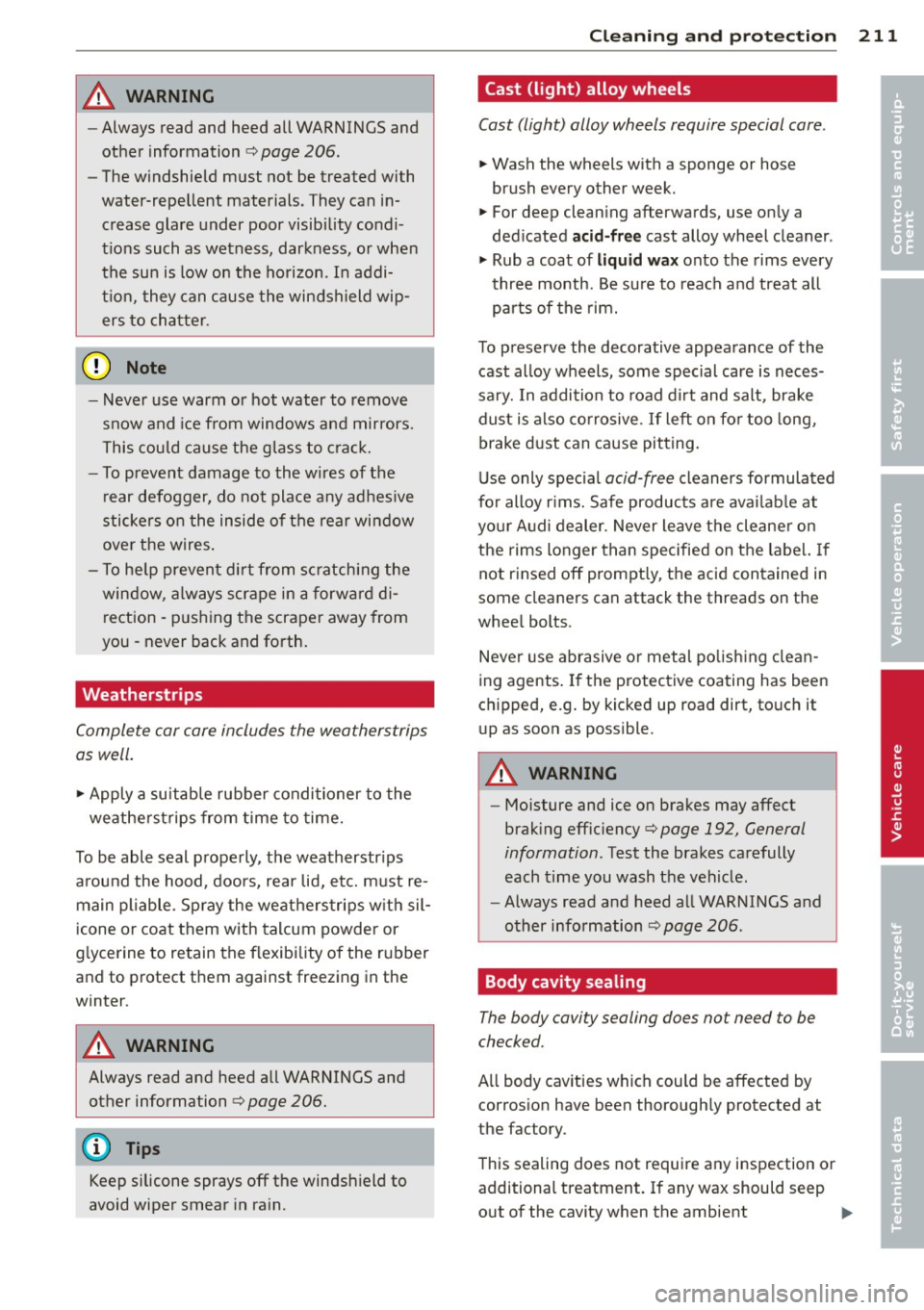
A WARNING ,~
- Always read and heed all WAR NINGS and
other information
c:> pag e 206.
- The w indshield must not be treated with
water -repe llent materials. They can in
creas e glare under poor visibility condi
t ions such as wetness, darkness, or when
the sun is low on the horizon. In addi
ti on, they can cause the windshield wip
ers to cha tter.
(D Note
- Never use warm or hot water to remove
snow and ice from windows and m irrors.
This cou ld cause the g lass to c rack.
- To prevent damage to the wires of the
r ear defogger, do not place a ny ad hesive
stickers on the inside of the rear wi ndow
ove r the wires .
- To he lp prevent di rt from sc ratching the
window, always scr ape in a forw ard d i
rection - p ush ing the scraper away from
you - never back and fo rth.
Weatherstrips
Complete car care includes the weatherstrips
as well .
.,. Apply a suitab le rubber condi tioner to the
weathe rstrips from time to time.
To be able seal p roperly, the weatherstr ips
a round the hood, doors, rear lid, e tc. m ust re
main pliable . Spray the weatherstrips w ith sil
i cone or coat them with talcum powder or
g lycerine to retain the flexibility of the rubber
and to protect them against freezing in the
winter .
A WARNING
Always read and heed all WARNINGS and other information
c:> page 206.
Keep s ilicone sprays off the windsh ield to
avoid wiper smear in ra in.
Cleaning and protec tion
Cast (light) alloy wheels
Cast (light) alloy wheels require special care.
.,. Wash the wheels with a sponge or hose
brush every other week.
.,. For deep clean ing afterwards, use o nly a
ded icated acid-fr ee cast alloy wheel cleaner .
.,. Rub a coat of liquid wax onto the rims every
three month. Be sure to reach and treat all
pa rts of the rim.
To preserve the decorative appearance of the cast alloy wheels, som e special care is neces
sa ry. In addi tion to road d irt and salt, brake
dust is a lso co rrosive . If left on fo r too long,
brake d ust can cause pitt ing.
Use only spec ia l
acid-free cleaners formulated
fo r alloy r ims. Safe produc ts are ava ilab le at
yo ur Audi dealer. Never leave the cleane r on
the rims longer than specified on the label. If
not rinsed off prompt ly, the acid con tained in
some cleaners can attack the threads on the
whee l bolts .
Never use abrasive o r metal po lis hi ng clean
ing agents .
If the protective coating has been
c h ipped, e.g . by kicked up road dirt, to uch it
u p as soon as possible .
A WARNING
--Moisture and ice o n brakes may affect
brak ing eff ic iency
c:> page 192, General
information.
Test the brakes ca refully
each time you wash the vehicle.
- Always read and heed a ll WARNINGS and
other info rmation
¢ page 206.
Body cavity sealing
The body cavity sealing does not need to be
checked.
A ll body cavities which could be affected by
corros ion have been thorough ly protected at
the factory.
T his sealing does not require any inspection or
additional treatment. If any wax should seep
o ut of the cavity when the ambient
Iii>-
21 1
•
•
Page 240 of 302
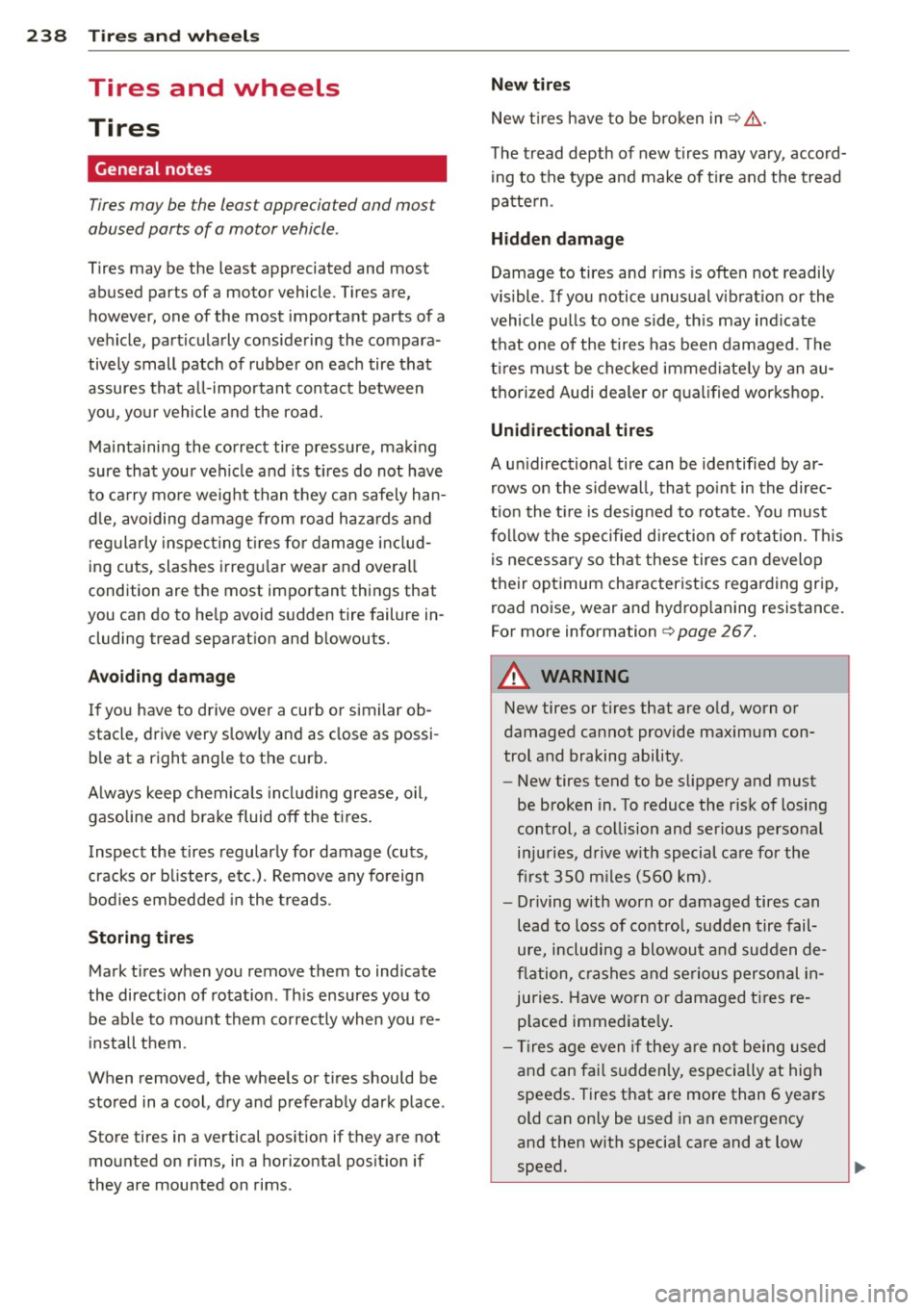
238 Tir es and whee ls
Tires and wheels
Tires
General notes
Tires may be the least appreciated and most
abused parts of a motor vehicle .
Tires may be the least appreciated and most
abused parts of a motor vehicle. Tires are,
however, one of the most important parts of a
vehicle, particularly considering the compara
tive ly small patch of rubber on each tire that
assures that a ll-important contact between
you, your vehicle and the road.
Maintaining the correct tire pressure, mak ing
sure that your vehicle and its tires do not have
to carry more weight than they can safe ly han
d le, avoiding damage from road hazards and
reg ularly inspecting t ires for damage includ
ing cuts, slashes irregu la r wear and ove rall
condition are the most important things that
you can do to he lp avoid sudden tire failure in
cluding tread separat ion and blowouts.
A voidin g damage
If you have to drive over a curb or similar ob
stacle, drive very s low ly and as close as possi
b le at a right angle to the curb.
A lways keep chem icals includ ing grease, oil,
gasoline and b rake fluid off the tires.
Inspect the tires regularly for damage (cuts,
cracks or b listers, etc.). Remove any fo reign
bod ies embedded in the treads.
St oring tire s
Mark tires when you remove them to indicate
the direction of rotation . Th is ensures you to
be ab le to mount them correctly when you re
install t hem.
When removed, the wheels or t ires should be
stored in a cool, d ry and preferably dark place .
Store tires in a vertical position if they are not mounted on rims, in a horizontal pos it ion if
they are mounted on rims.
N ew tire s
New tires have to be broken in¢&,. .
The tread depth of new t ires may vary, accord
ing to the type a nd make of t ire and the tread
pattern .
Hidden damag e
Damage to tires and r ims is often not readily
vis ible . If you notice unusual v ibrat ion or the
vehicle pulls to one s ide, th is may ind icate
t h at one of the t ires has been damaged . T he
t ir es must be checked immed iate ly by an au
thorized Aud i dea le r or q uali fied wor kshop.
Unidirection al t ire s
A un idirectional tire can be identified by ar
rows on the sidewall, that po int in the direc
t ion the t ire is designed to rotate. You must
fol low the specified direction of rotation . This
is necessary so that these tires can develop
their optimum characteristics regarding grip,
road noise, wear and hydrop laning resistance.
For more information ¢
page 267.
A WARNING
-New tires or tires that are old, worn or
damaged cannot provide maximum con
trol and braking ability .
-
-New tires tend to be slippery and must
be broken in . To reduce the risk of losing
control, a co llision and ser ious personal
in ju ries, d rive w ith special ca re for the
fi rst 350 m iles (560 km).
- Driving with worn or damaged tires can
lead to loss of control, sudden tire fail
ure, including a blowou t and sudden de
flation, c rashes and serious personal in
juries . Have worn or damaged tires re
p laced immediate ly .
- Tires age even if they are not being used
and can fai l sudden ly, especially at high
speeds. Tires that are more than 6 years
old can only be used in an emergency
and then w ith specia l care and at low
speed.
Page 245 of 302
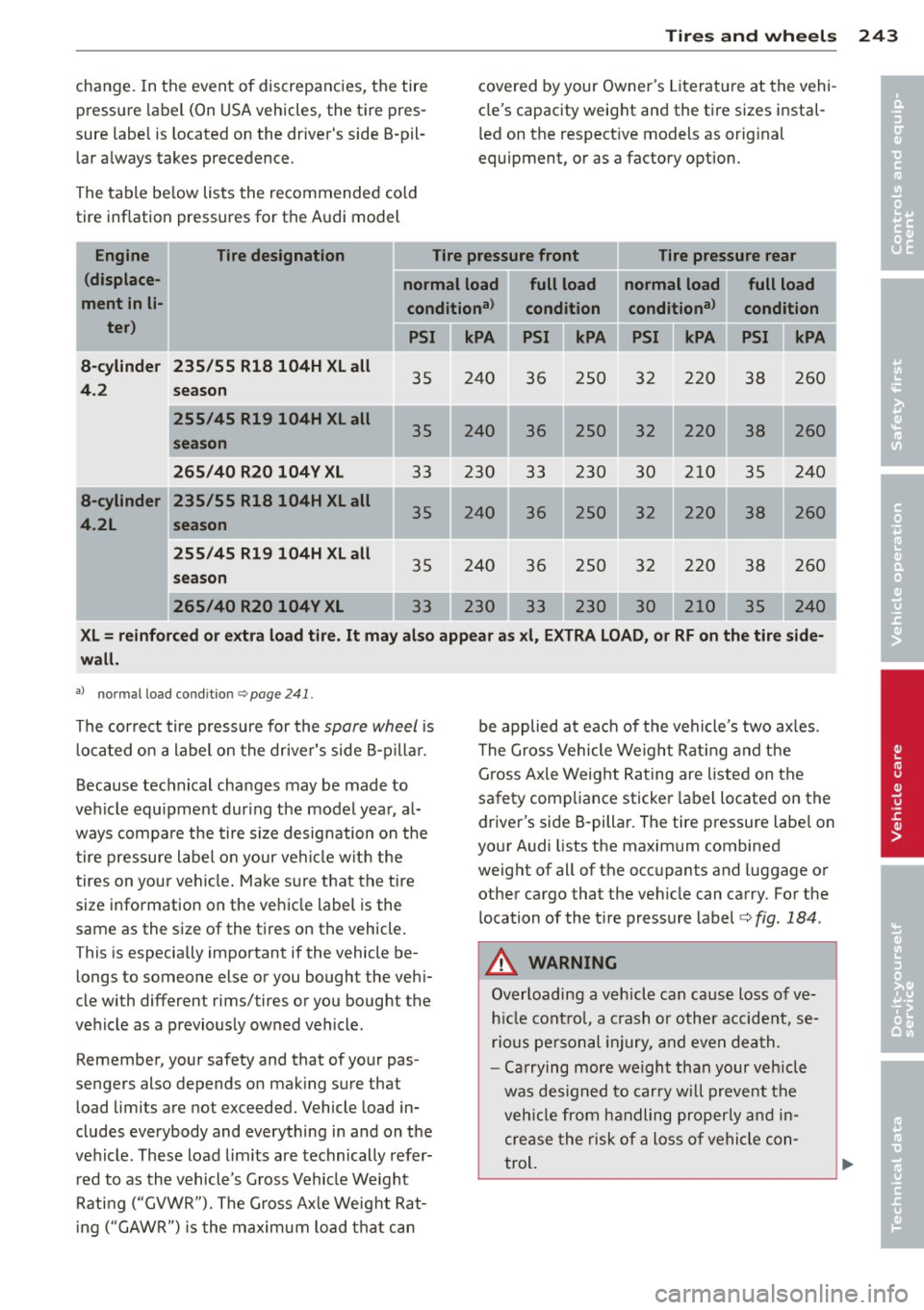
Tires and wheels 243
change. In the event of discrepancies, the tire
pressure label (On USA vehicles, the tire pres
sure label is located on the dr iver's side B -pil
lar always takes precedence.
The table be low lists the recommended cold
tire inflation pressures for the A udi model covered
by your Owner 's Literat ure at the vehi
cle's capacity weight and the ti re sizes instal
l ed on the respective models as orig inal
equipment, or as a factory option.
Engine Tire designation Tire pressure front Tire pressure rear
(displace- normal load full load normal load full load
ment in
li-conditiona l
condition conditional
condition
ter) kPA PSI kPA PSI kPA PSI kPA
a-cylinder 235/55 Rla 104H XL all
35 240 36 250 32 220 38 260 4.2
season
255/45 R19 104H XL all
240 36 250 32 220 38 260
season
265/40 R20 104V XL
33 230 33 230 30 210 35 240
a-cylinder 235/55 R18 104H XL all 240
36 250 32 220
38 260
4.2L season
255/45 R19 104H XL all
35 240 36 250 32 220 38 260 season
265/40 R20 104V XL 240
XL= reinforced or extra load tire. It may also appear as xl, EXTRA LOAD, or RF on the tire side-
wall.
al normal load co ndit io n c:, page 24 1.
The correct tire pressure for the spore wheel is
located on a label on the driver's side B-p illar.
Because technical cha nges may be made to
vehicle equipment during the model year , a l
ways compa re the tire size designation on the
tire pressure label on your ve hicle with the
tires on your vehicle . Make sure that the tire
size information on the vehicle label is the
same as the size of the tires on the vehicle.
T his is especially important if the vehicle be
longs to someone else or you bought the vehi
cle wi th different rims/ tires or you bought the
vehicle as a previously owned vehicle .
Remember, your safety and that of your pas
sengers also depends on mak ing sure that
load limits are not exceeded. Vehicle load in
cludes everybody and everything in and on the
veh icle. These load lim its are technically refer
red to as the vehicle's Gross Vehicle Weight
Rating ("GVWR"). The Gross Axle Weight Rat
in g ("GAWR") is the maximum load that can be applied at each
of the vehicle's two axles.
T he Gross Vehicle Weight Rating and the
Gross Axle Weight Rating are listed on the
safety compliance sticker label located on the
driver's side B-pillar . The tire pressure labe l on
your Audi lists the maximum combined
weight of all of the occupants and luggage or
other cargo tha t the veh icle can carry . For the
location of the tire pressure label
c::> fig. 184.
A WARNING
Overloading a vehicle can cause loss of ve
hicle control, a crash or other accident, se
rious personal injury, and even death.
- Carrying more weight than your vehicle
was designed to carry will prevent the
vehicle from handling properly and in crease the risk of a loss of vehicle con
trol.
•
•
Page 251 of 302

A WARNING
Sudden tire failure can lead to loss of con
trol, a crash and serious personal injury!
- Never drive a vehicle when the tread on
any tire is worn down to the wear indica
tors.
- Worn tires are a safety hazard, they do
not grip well on wet roads and increase
your risk of "hydroplaning" and loss of
control.
- Always keep chemicals that can cause
tire damage, such as grease, oil, gasoline
and brake fluid away from t ires.
- Tires age even if they are not be ing used
and can fail suddenly, especially at high
speeds . Tir es that are more than 6 years
old can only be used in an emergency
and then with special care and at lower
speeds.
- Never mount used tires on your vehicle if
you are not sure of their" previous histo
ry ." Old used tires may have been dam
aged even though the damage cannot be
seen that can lead to sudden tire failure
and loss of vehicle control.
Tires and wheels 249
New tires and replacing tires and wheels
New tires and wheels have to be broken in .
Fig. 188 Tir e specificat ion codes on t he s idewall o f a
tire
No. Description
CD Passenger car tire (where applicable)
@ Nominal w idth of tire in millimeters
® Ratio of height to width (aspect ratio)
© Radial
® Rim diameter code
® Load index and speed rating
(f) U.S. DOT tire identification number
® Audi Origina l tire
® Sever snow conditions
@ T ire ply composition and materials
used
@ Maximum load rating
@ Treadwear, traction and temperature
grades
@ Maximum permissible inflation pres-
sure
The tires and rims are essential parts of the
vehicle's design . The tires and rims approved
by Audi are spec ially matched to the charac
teristics of the vehicle and can make a major .,.
•
Page 253 of 302

T up to 118 mph (190 km/h)
U up to 124 mph (200 km/ h)
H up to 130 mph (210 km/ h)
V up to 149 mph (240 km/h)1
)
Z over 149 mph (240 km/h)l)
W up to 168 mph (270 km/h)l)
Y up to 186 mph (298 km/h)l)
Your veh icle is no rma lly factory equipped with
tires , which possess excellent driving charac
teristics and give your Audi opt imum driving
comfort . An e lectronic speed limiter
c::> page 28 wi ll normally prevent you r vehicle
from go ing fa ster th an the tire speed ra ting
c:::> .& .
U.S . DOT T ire Identificat ion Numb er (TIN )
and tire manufacture date
This is the t ire's "se rial number" . It begins
wi th the letters "DOT" and indicates that the
tire meets all federal standards . The next two
numbers or letters indicate the plant where it
was manufactured, and the last four numbers r epresent the week and year of manufacture.
F or
examp le, the numbers 22 10 mean the ti re
was prod uced in the 22nd week of 2010. The
other numbers are marketing codes that may
or may not b e used by the tire manufacturer .
T his information is used to contact consumers
i f a t ire defect requires a reca ll.
Aud i original tir e
Tires with t he identification "AO" or "RO" have
been specia lly matched w ith your Audi . We
recommend using only these tires because
they meet the highest standards regard ing
sa fety and driving character istics when used
correctly . Your authorized Audi dealer will
gladly provide you with more information .
Tire ply compo sit ion and materi als used
The number of plies indicates the number of
layers of rubber-coated fabric in the t ire. In
general, the greater the number of plies, the more weight a tire can support. Tire manufac -
llFt· "h · or ires wit a m ax im um spee d cap abil ity over 149
mph (2 4 0 k m/h) , tire man ufacturers some times u se
th e le tters "Z R."
Tire s an d wheel s 251
ture rs also must indicate the mate rials in the
tire , which include stee l, nylon , po lyester, and
others .
Maximum Load Rating
This number ind icates the maximum load in
k ilograms and po unds that can be ca rr ied by
the tire.
Tire quality grading for treadwear ,
traction, and t emp eratur e resistanc e
Tre ad wear, t raction and tempera ture grades
c::> page 2 52 .
Maximum Permissible Inflation Pressure
This number is the greatest amount of a ir
pressure that should ever be put in the t ire
u nder norma l dr iv ing cond itions .
_&. WARNING ,-=
-Using incorrect o r unmatched tires and/
or wheels or improper tire and wheel
comb inations can lead to loss of control
'
coll is ion and serious personal inj ury.
- Always use tires, rims and whee l bolts
that meet the specifications of original
factory- insta lled tires or other combina
tions that have been specifically ap proved by the vehicle manufacturer.
- Tires age even if they are not being used
and can fail suddenly , especially at high
speeds . Tires that are more than 6 years
old can only be used in an emergency
and then w ith special care and at lower
speeds.
- Never mo unt used tires on your veh icle if
you are not sure of thei r "previous histo
ry." O ld used tir es may have been dam
aged even though the damage cannot be
seen that can lead to sudden tire fai lure
and loss of vehicle control.
- All four whee ls must be fitted with radial
tires of the same type, size (rolling cir
cumference) and the same tread pattern .
~
•
•
Page 254 of 302
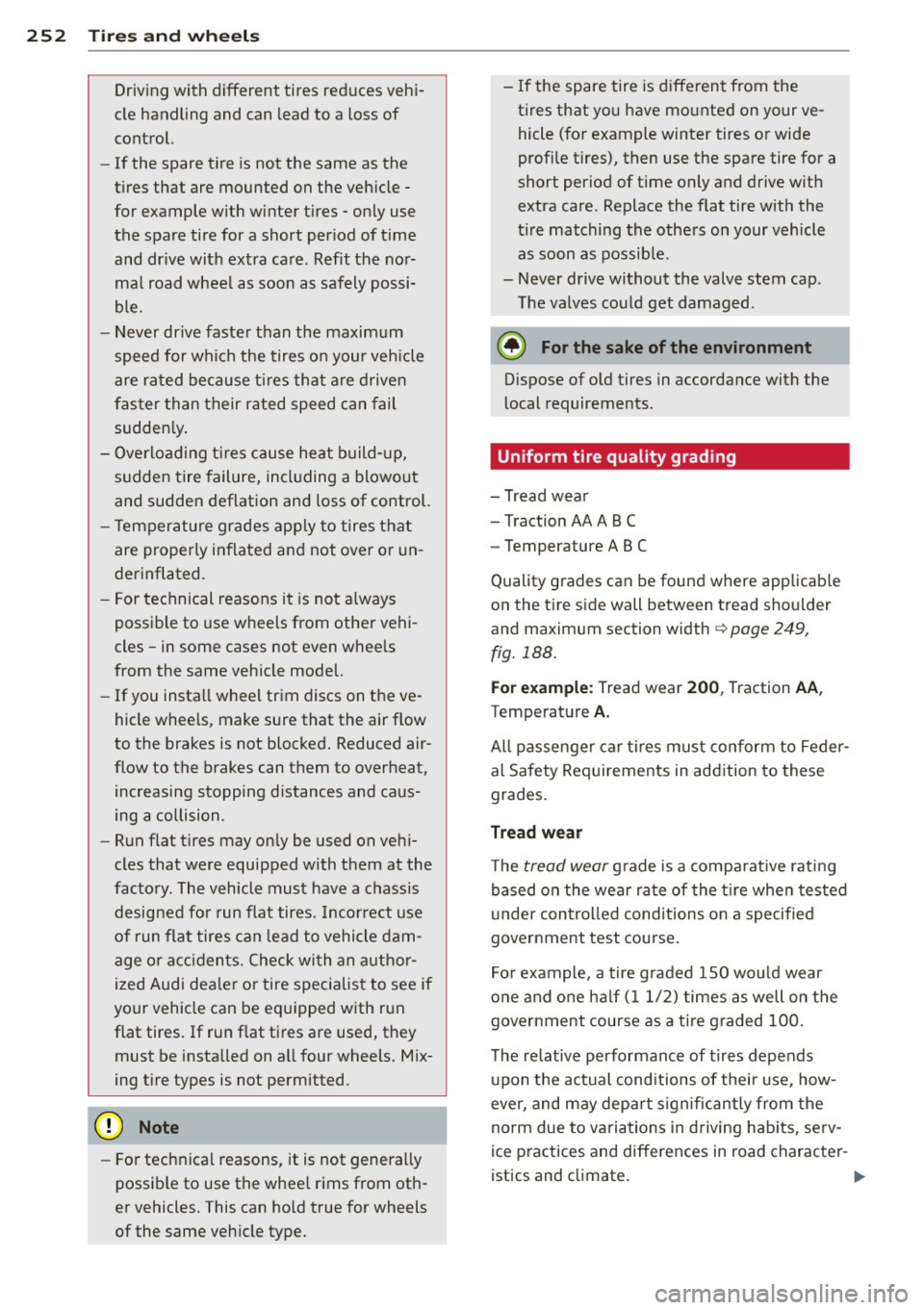
252 Tir es and whe els
Driving with different tires reduces vehi
cle handling and can lead to a loss of
control.
- If the spare tire is not the same as the
tires that are mounted on the veh icle -
for example with winter tires - only use
the spare tire for a short period of time
and dr ive with extra care . Refit the nor
ma l road wheel as soon as safely possi
ble.
- Never drive faster than the maximum
speed for which the tires on your veh icle
are rated because ti res that a re driven
faster than their rated speed can fail
sudden ly .
- Overloading t ires cause heat build- up,
sudden tire failure, including a blowout
and sudden deflation and loss of control.
- T emperature grades app ly to tires that
are properly inflated and not over o r un
derinflated .
- For technical reasons it is not a lways
possible to use wheels from other vehi
cles -in some cases not even whee ls
from the same vehicle model.
- If you install wheel trim discs on the ve
hicle whee ls, make sure that the air f low
to the brakes is not blocked. Reduced air
flow to the brakes can them to overheat, increasing stopping distances and caus
ing a collision .
- Run flat t ires may only be used on vehi
cles that were equipped with them at the
factory . The vehicle must have a chassis
designed for run flat tires . Incorrect use
of run flat tires can lead to vehicle dam
age or acc idents. Check with an a uthor
ized Audi dea le r or tire specialist to see if
yo ur vehicle can be equipped with run
flat tires. If run f lat tires are used, they
must be insta lled on all four wheels. Mix
ing t ire types is not permitted .
- Fo r technical reasons , it is not genera lly
possib le to use the whee l rims from oth
er vehicles. This can ho ld true for wheels
of the same veh icle type. - If the spare tire is different from the
tires that yo u have mounted on your ve
hicle (for example winter tires or wide
profile tires), then use the spare tire for a
short period of time only and drive w ith
extra care. Replace the flat tire w ith the
tire matching the others on your vehicle
as soon as possib le .
- Never drive without the valve stern cap .
The valves cou ld get damaged .
@) For the sake of the environment
Dispose of o ld tires in accordance with the
local requirements .
Uniform tire quality grading
-Tread wear
- Traction AA AB C
- Tempe ra tu re ABC
Quality grades can be found whe re applicab le
on the tire sid e wall betw een tr ead shou ld er
a nd maximum section width
c> page 249,
fig. 188 .
For ex ample: Tread wear 200 , Tract ion AA ,
Temperatur e A.
All passenger car t ires must conform to Feder
al Safety Requirements in add ition to these
grades.
Tread wear
T he tread wear grade is a comparative rating
based on the wear rate of the t ire when tes ted
u nder contro lled cond itions on a specified
government test course .
For example, a tire graded 150 would wear
one and one ha lf (11/2) times as well on the
government course as a tire graded 100.
T he relative performance of tires depends
upon the actual conditions of thei r use, how
ever, and may depa rt s ignificantly from the
norm due to va riations in driving hab its, se rv
ice practices and differences in road character -
istics and cl imat e. ..,.
Page 257 of 302
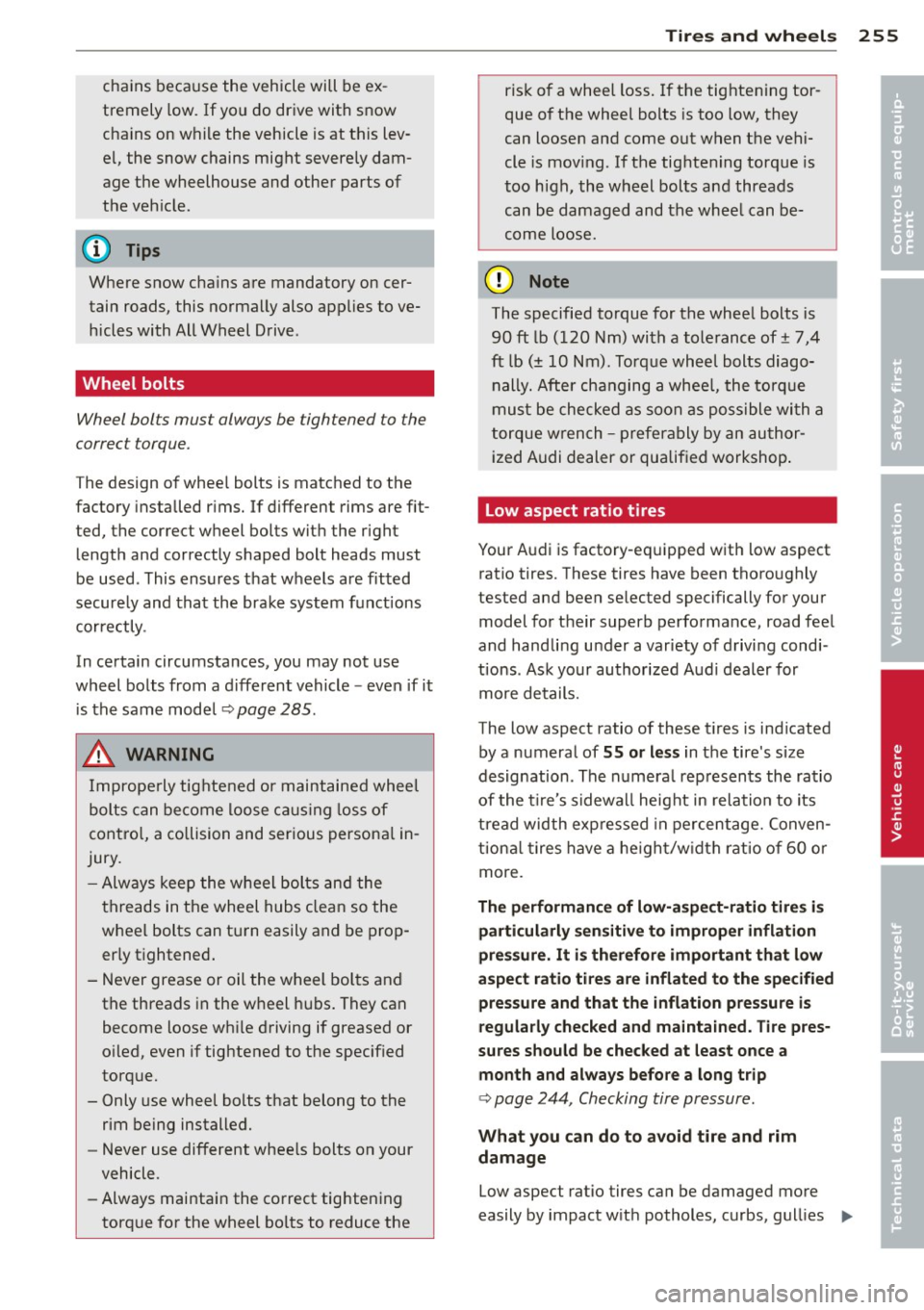
chains because t he vehicle will be ex
tremely low. If you do drive with snow
chains on while the vehicle is at this lev
el, the snow chains might severe ly dam
age the wheelhouse and other parts of
the veh icle.
@ Tips
Where snow cha ins are mandatory oncer
tain roads, this normally also applies to ve
hicles with All Wheel Drive.
Wheel bolts
Wheel bolts must always be tightened to the
correct torque .
The design of whee l bolts is matched to the
factory installed r ims. If different rims are fit
ted, the correct wheel bolts with the right length and correctly shaped bolt heads must
be used . This ensures that wheels are fitted
secure ly and that the brake system f unctions
correctly .
In certain circumstances, you may not use
wheel bolts from a d iffe rent vehicle -even if it
i s the same mode l
¢page 285.
A WARNING
Imprope rly tig hte ned or maintained whee l
bolts can be come loose causing loss of
contro l, a co llision and serious persona l in
jury .
- Alw ays keep the w heel bolts and the
th reads in the wheel hubs clea n so the
wheel bolts can turn easily and be prop
er ly tightened .
- Never grease or oil the wheel bo lts and
the threads in the w heel h ubs. They can
become loose wh ile driving if greased or
o iled, even if tightened to the specif ied
torque.
- Only use wheel bolts that belong to the
rim being installed.
- Never use different whee ls bolts on your
vehicle.
- Always maintai n the co rrect tightening
torq ue for the wheel bo lts to reduce the
Tire s an d wheel s 255
risk of a wheel loss. If the tightening tor
que of t he wheel bolts is too low, they
can loosen and come out when the vehi
cle is mov ing. If the tighte ning torque is
too h igh, the wheel bol ts and threads
can be damaged and the whee l can be
come loose.
(I) Note
The specified torque for the whee l bolts is
90 ft lb ( 120 Nm) wi th a tole rance of± 7,4
ft lb(± 10 Nm). Torq ue whee l bolts diago
nally. Afte r cha nging a whee l, the torq ue
must be checked as soon as possible wi th a
torque w rench -prefe rably by an au thor
ized Audi dealer or qualif ied workshop .
Low aspect ratio tires
Your Audi is facto ry-eq uipped with low aspect
ratio tires. These tires have been thoro ughly
tested and been se lected specifically for your
model for their superb performance, road fee l
and handling u nder a variety of driving cond i
tions . Ask your authorized Audi dealer for
more details.
The low aspect ratio of these t ires is ind icated
by a numeral of
55 or less in the tire's size
designation . The numeral rep resents the ratio
of the t ire's sidewall height in relation to its
t read width ex pressed in pe rce ntage. Conven
tiona l tires have a he igh t/w idth ratio of 60 or
more.
The performance of low-aspe ct-ratio tire s is
particularly sensitiv e to improper infla tion
pres sure. It is therefore important that low
a spect ratio tires are inflated to the specified
pre ssure and that the inflation pressure i s
regularly checked and maintained. Tire pre s·
sures should be checked at least once a
month and always befo re a long trip
¢ page 244, Checking tire pressure.
What you can d o to avoid tire and rim
damage
Low aspect ratio tires can be damaged more
easily by impact w it h potholes , curbs, gul lies ..,.
•
•
Page 269 of 302

and the hub. R emove a ll dirt from these
su rfaces before remo unt ing the wheel.
Tires with unidirectional tread design
Tires with unidirectional tread de sign must be
mounted with their tread pattern pointed in
the right direction.
Using a spare tire with a tread pattern
intended for use in a specific direction
When using a spa re tire w ith a tread patte rn
inte nded for use in a specific direction, please
note t he following:
- T he direction o f rotation is marked by an a r
r ow on the side of the tire.
- If the spare tire has to be install ed in the in
correct di rection, use the sp are tire only
temporar ily since the t ire will not be a ble to
achieve its optimum pe rformance character
ist ics with regard to aquaplaning, noise and
wear.
- We recommend that you pay particular at
tent ion to this fact during wet weat he r and
t h at you adjust your speed to matc h road
condit ions .
- Replace the flat tire w ith a new one and
have it installed on your ve hicle as soon as
poss ib le to restore the hand ling advantages
of a uni direct io na l ti re .
Notes on wheel changing
Pl ease rea d the information ¢ page 2 49, New
t ires and repl acing tires and wheels
if you are
goi ng to use a s pare t ire which is differen t
from the tires on your ve hicle.
Afte r you cha nge a tire:
- Check the tire pressure on the spare imme
diately after installation .
- Have the wheel bolt tightening torque
checked with a torque wrench as soon as
possible by your authorized Audi dealer or
a qualified service station .
- With steel and alloy wheel rims, the wheel
bolts are correctly tightened at a torque of
90 ft lb (120 Nm). What do I do now? 267
-
If you notice that the wheel bolts are cor
roded and difficult to turn while changing
a tire , they should be replaced before you
check the t ightening torque.
- Replace the flat ti re with a new one and
have it installed on your vehicle as soon as
possible. Remount the wheel cover.
Until then , drive with extra care and at re
duced speeds.
A WARNING
- I f you are g oing to eq uip your vehicle
wit h tires o r rims which differ from those
which were factory installed, then be sure to read the information
¢ pag e 249,
N ew tires and replacing tires and
w heels.
- Always ma ke sure t he damag ed wheel o r
e ven a fla t tire an d the jack a nd tool ki t
a re prope rly se cu red in t he luggage co m
p art me nt and a re not loo se in the pas
senger compartment .
- I n an a ccide nt or sudde n maneuver they
could fly forward, injuring anyone in the
veh icle.
- Always s tore da mage d wheel, j ack and
t oo ls se curely in the lugg age comp art
men t. Othe rwise, in an accident o r su d
den maneuver they co uld f ly forwa rd,
causing inju ry to passengers in the veh i
cle.
- Do not use commerc ia lly available t ire
sealants. Othe rwise, the electrical com
ponents of the tire pressure mon itor ing
system * will no lo nger work p roperly and
the sensor for the tire p ress ure monito r
i n g sys tem * will have to be re placed by a
qua lified wor kshop. •
•